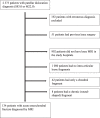The influence of primary treatment approach on outcomes in patients with osteochondral fracture after patellar dislocation: a case series
- PMID: 37055823
- PMCID: PMC10099836
- DOI: 10.1186/s43019-023-00186-2
The influence of primary treatment approach on outcomes in patients with osteochondral fracture after patellar dislocation: a case series
Abstract
Background: We characterized the relation of primary treatment approaches to the need of later surgical interventions and the outcomes of patellar dislocation in patients with patellofemoral osteochondral fracture (OCF).
Methods: Overall, 134 patients with OCF were categorized in two groups according to treatment approach: primary surgery (operation within 90 days from injury) and conservative treatment. Data on surgical procedures, OCF characteristics, and patellofemoral anatomy were retrospectively collected. To measure subjective outcomes, 54 patients completed the knee-specific patient-reported outcome measures (PROMs) Kujala score, Tegner activity scale, the knee injury and osteoarthritis outcome score (KOOS) quality of life (QoL) subscale, and visual analog scale pain items.
Results: The mean follow-up time was 4.9 years [standard deviation (SD) 2.7 years]. The primary treatment approach was surgery in 73 patients (54%) and conservative in 61 patients (46%) of whim 18 (30%) needed late surgery. Of primary surgery patients, the OCF was reimplanted in 45 patients (62%) and removed in the rest. Of all patients, 31 needed surgery in the later phase after the primary treatment approach (either reoperation or surgery after insufficient outcome of conservative treatment). In conservatively treated patients, OCF was smaller and patellofemoral joint malformation was more severe than in surgery group. Among patients who completed the PROMs, the outcomes appeared generally acceptable in both groups.
Conclusions: Although a majority of the primary treatment approaches for OCF after patellar dislocation were definitive, one-fourth of patients required surgery in the later phase. PROMs did not indicate major differences between the study groups.
© 2023. The Author(s).
Conflict of interest statement
Dr. Uimonen reports personal scholarships from Tampereen Kaupungin Tiederahasto, Vappu Uuspää Foundation, and the Finnish Research Foundation for Orthopaedics and Traumatology. Other authors declare no conflicts of interest.
Figures
Similar articles
-
Clinical outcomes after absorbable suture fixation of patellar osteochondral fracture following patellar dislocation.Ann Transl Med. 2019 Apr;7(8):173. doi: 10.21037/atm.2019.03.52. Ann Transl Med. 2019. PMID: 31168454 Free PMC article.
-
Osteochondral Fractures in Acute Patellar Dislocations in Adolescents: Midterm Results of Surgical Treatment.Orthop J Sports Med. 2022 Jul 14;10(7):23259671221107608. doi: 10.1177/23259671221107608. eCollection 2022 Jul. Orthop J Sports Med. 2022. PMID: 35859644 Free PMC article.
-
Initial conservative treatment of osteochondral fracture of the patella following first-time patellar dislocation.BMC Musculoskelet Disord. 2020 Sep 17;21(1):617. doi: 10.1186/s12891-020-03641-3. BMC Musculoskelet Disord. 2020. PMID: 32943024 Free PMC article.
-
Conservative versus repair of medial patellofemoral ligament for the treatment of patients with acute primary patellar dislocations: A systematic review and meta-analysis.J Orthop Surg (Hong Kong). 2020 Jan-Apr;28(2):2309499020932375. doi: 10.1177/2309499020932375. J Orthop Surg (Hong Kong). 2020. PMID: 32552381
-
Patterns in Outcomes Reporting of Operatively Managed Pediatric Patellofemoral Instability: A Systematic Review and Meta-analysis.Am J Sports Med. 2019 May;47(6):1516-1524. doi: 10.1177/0363546518765152. Epub 2018 Apr 9. Am J Sports Med. 2019. PMID: 29630397
Cited by
-
Medial patellofemoral ligament reconstruction appears to be a better treatment than repair, proximal realignment, or conservative management for primary patellar dislocation: A network meta-analysis.Medicine (Baltimore). 2023 Sep 29;102(39):e35251. doi: 10.1097/MD.0000000000035251. Medicine (Baltimore). 2023. PMID: 37773862 Free PMC article.
-
Pediatric osteochondral fractures: clinical insights associate early diagnosis to early rehabilitation via arthroscopy.Eur J Orthop Surg Traumatol. 2024 Apr;34(3):1657-1665. doi: 10.1007/s00590-024-03852-7. Epub 2024 Feb 20. Eur J Orthop Surg Traumatol. 2024. PMID: 38376585 Free PMC article.
References
-
- Smith TO et al (2015) Surgical versus non-surgical interventions for treating patellar dislocation. Cochrane Database Syst Rev (2): CD008106 - PubMed
LinkOut - more resources
Full Text Sources




